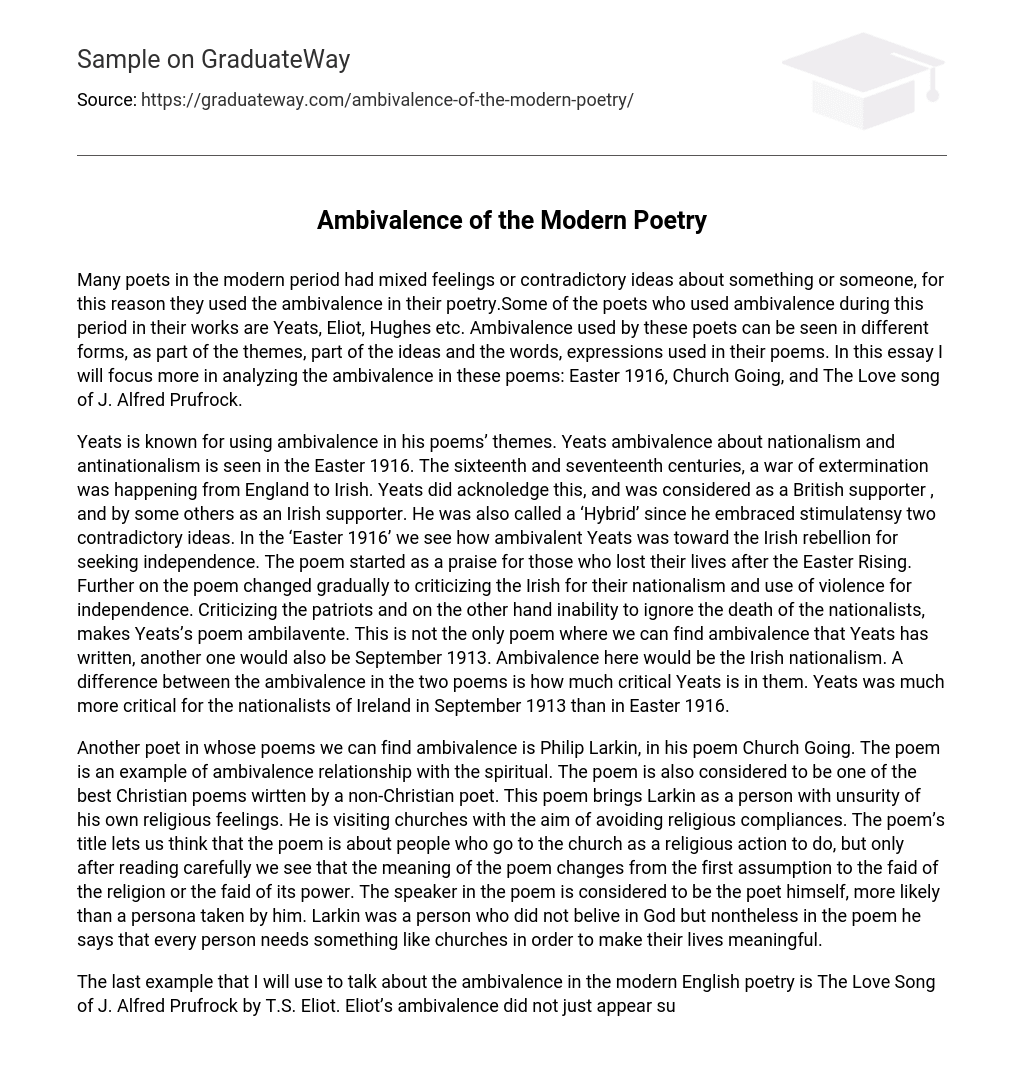Many poets in the modern period had mixed feelings or contradictory ideas about something or someone, for this reason they used the ambivalence in their poetry.Some of the poets who used ambivalence during this period in their works are Yeats, Eliot, Hughes etc. Ambivalence used by these poets can be seen in different forms, as part of the themes, part of the ideas and the words, expressions used in their poems. In this essay I will focus more in analyzing the ambivalence in these poems: Easter 1916, Church Going, and The Love song of J. Alfred Prufrock.
Yeats is known for using ambivalence in his poems’ themes. Yeats ambivalence about nationalism and antinationalism is seen in the Easter 1916. The sixteenth and seventeenth centuries, a war of extermination was happening from England to Irish. Yeats did acknoledge this, and was considered as a British supporter , and by some others as an Irish supporter. He was also called a ‘Hybrid’ since he embraced stimulatensy two contradictory ideas. In the ‘Easter 1916’ we see how ambivalent Yeats was toward the Irish rebellion for seeking independence. The poem started as a praise for those who lost their lives after the Easter Rising. Further on the poem changed gradually to criticizing the Irish for their nationalism and use of violence for independence. Criticizing the patriots and on the other hand inability to ignore the death of the nationalists, makes Yeats’s poem ambilavente. This is not the only poem where we can find ambivalence that Yeats has written, another one would also be September 1913. Ambivalence here would be the Irish nationalism. A difference between the ambivalence in the two poems is how much critical Yeats is in them. Yeats was much more critical for the nationalists of Ireland in September 1913 than in Easter 1916.
Another poet in whose poems we can find ambivalence is Philip Larkin, in his poem Church Going. The poem is an example of ambivalence relationship with the spiritual. The poem is also considered to be one of the best Christian poems wirtten by a non-Christian poet. This poem brings Larkin as a person with unsurity of his own religious feelings. He is visiting churches with the aim of avoiding religious compliances. The poem’s title lets us think that the poem is about people who go to the church as a religious action to do, but only after reading carefully we see that the meaning of the poem changes from the first assumption to the faid of the religion or the faid of its power. The speaker in the poem is considered to be the poet himself, more likely than a persona taken by him. Larkin was a person who did not belive in God but nontheless in the poem he says that every person needs something like churches in order to make their lives meaningful.
The last example that I will use to talk about the ambivalence in the modern English poetry is The Love Song of J. Alfred Prufrock by T.S. Eliot. Eliot’s ambivalence did not just appear suddenly, he was divided within and against himself by the time he finished his studies. The speaker in this poem has ambivalence thoughts and actions in the sense that he is very hesitant and postpones taking actions which do not motivate him. The speaker has a lot of desires and dreams, but being a person that postpones taking actions ,he fails to make them real. Some of the phrases that characterize Prufrock as ambivalent are ‘ do I dare’ , ‘ there’s time to turn back’, ‘decisions and revisions which a minute will reverse’ etc. Because of the ambivalence Prufrock provides an example of a person who is rather beneficial to civilization’s existence. This is not only because of his tendency not to act, but also due to the success of his super-ego in repressing or redirecting his aggressive instinct.
As mentioned at the beginning, these are only some samples of the ambivalence used in the Modern English Poetry. The poets used ambivalence in order to express their own mixed thoughts and feelings about what they wrote and were interested to write for, discuss. This was done through a persona/speaker in the above poems.
References
- Khan, Jalal Uddin. (1998). Yeats’s “Easter 1916” and Irish nationalism. World Literature in English. 37: 1-2, 42-59. Norton Anthology V2.





